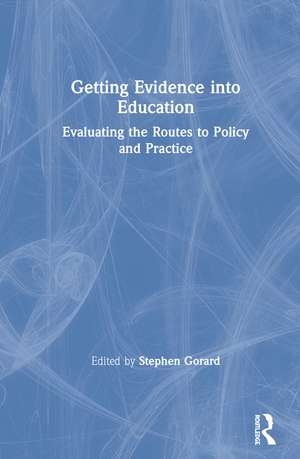Getting Evidence into Education: Evaluating the Routes to Policy and Practice
Editat de Stephen Gorarden Limba Engleză Hardback – 20 apr 2020
Containing a variety of case studies, from evidence-based policies for early childhood education in Brazil, to the use of evidence on contextualized admissions to Scottish universities, the volume explores a variety of different ways to approach the problem, addressing the questions:
- What is the existing evidence on different approaches to getting research evidence into use?
- What are the factors which influence the uptake of high-quality research evidence by policy or practice?
- Which are the most effective pathways for evidence-into-use in particular contexts?
| Toate formatele și edițiile | Preț | Express |
|---|---|---|
| Paperback (1) | 288.41 lei 6-8 săpt. | |
| Taylor & Francis – 20 apr 2020 | 288.41 lei 6-8 săpt. | |
| Hardback (1) | 1001.84 lei 6-8 săpt. | |
| Taylor & Francis – 20 apr 2020 | 1001.84 lei 6-8 săpt. |
Preț: 1001.84 lei
Preț vechi: 1221.75 lei
-18% Nou
Puncte Express: 1503
Preț estimativ în valută:
191.70€ • 200.56$ • 159.25£
191.70€ • 200.56$ • 159.25£
Carte tipărită la comandă
Livrare economică 02-16 aprilie
Preluare comenzi: 021 569.72.76
Specificații
ISBN-13: 9780367258801
ISBN-10: 0367258803
Pagini: 260
Ilustrații: 42
Dimensiuni: 156 x 234 x 20 mm
Greutate: 0.5 kg
Ediția:1
Editura: Taylor & Francis
Colecția Routledge
Locul publicării:Oxford, United Kingdom
ISBN-10: 0367258803
Pagini: 260
Ilustrații: 42
Dimensiuni: 156 x 234 x 20 mm
Greutate: 0.5 kg
Ediția:1
Editura: Taylor & Francis
Colecția Routledge
Locul publicării:Oxford, United Kingdom
Public țintă
Postgraduate and UndergraduateCuprins
Section 1: Introduction to need for better evidence. Chapter 1: Why we need better use of good evidence in education. Chapter 2: The importance of providing evidence in education from rigorous evaluations. Chapter 3: The global evidence and architecture in health and education: a comparative scorecard. Chapter 4: What we know already about the best ways to get evidence into use in education. Section 2: Experiences of different routes to evidence use. Chapter 5: Hearts and minds: The Research Schools Network: from evidence to engagement. Chapter 6: The development and worldwide impact of the Teaching and Learning Toolkit. Chapter 7: Why is it difficult to get evidence into use? Chapter 8: Generating research evidence in teaching practice: Can teachers lead randomised control trials in education? Section 3: Engagement with impact in different phases of education. Chapter 9: First two years at school: Evidence-based policy for early childhood education in Brazil. Chapter 10: Resarch into practice: The case of classroom formative assessment. Chapter 11: Engagement and impact in addressing and overcoming educational disadvantage. Chapter 12: The use of evidence from research on contextualised admissions to widen access to Scottish universities. Section 4: The role of leadership in evidence uptake. Chapter 13: Is distributed leadership an effective approach for mobilising research-informed innovation across professional learning networks? Exploring a case from England. Chapter 14: The opportunities and challenges of leaders using evidence in education. Section 5: Suggestions for next steps in evidence use. Chapter 15: Towards a better understanding of quality of evidence use. Chapter 16: Where next for improving the use of good evidence.
Notă biografică
Stephen Gorard is Professor of Education and Public Policy at Durham University, UK and a Fellow of the Academy of Social Sciences.
Descriere
Containing a variety of case studies, from evidence-based policies for early childhood education in Brazil, to the use of evidence on contextualized admissions to Scottish universities, the volume explores a variety of different ways to approach the problem of getting evidence into Education.
